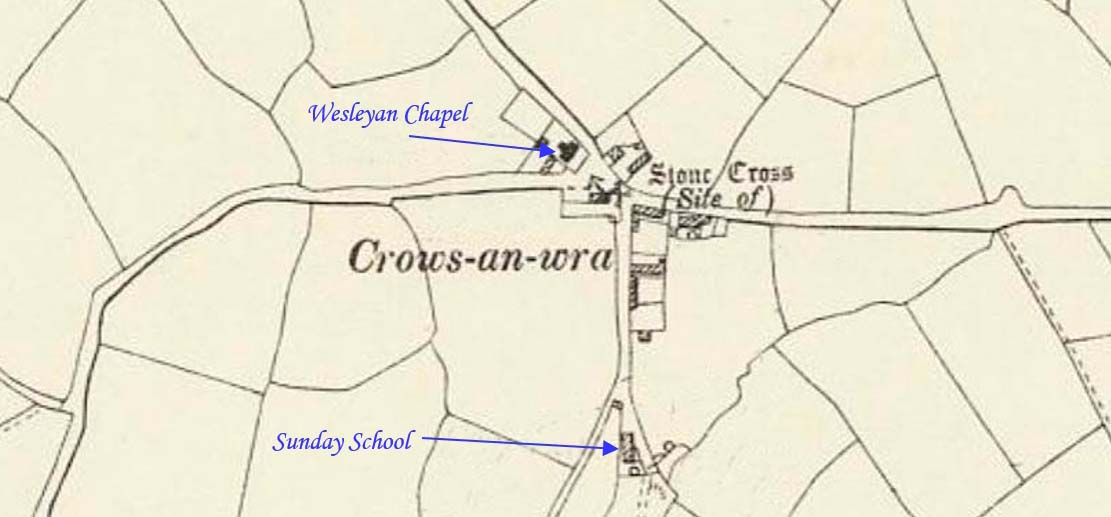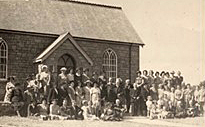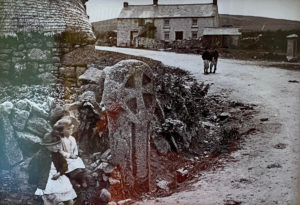
Crows-an-Wra is a hamlet in West Cornwall in the civil parish of St Buryan, Lamorna and Paul approximately four miles northeast of Land’s End. This profile of Crows an wra Wesleyan Chapel has been compiled by Jo Lewis and Tony Mansell.
Wesleyan Methodist chapel, replacing earlier chapel south of crossroads, which has become the Sunday school. Recorded only on the 2nd Edition 1:2500 1907 OS Map. Associated with Burial Ground to the north-west. Wesleyan chapel in small hamlet, now converted to house. Probably very late C19 with simple Gothic style features, built of dressed granite brought to course. Gabled entrance porch with Y-traceried fanlight central to front side and canted apse to left-hand end. Low granite forecourt wall plus granite gate-piers and cast-iron gates. Part of an interesting group including a wayside cross and a painted granite guidepost which is one of the best examples in Cornwall. (Heritage Gateway)
The original C19 Wesleyan Methodist chapel lies to the south of the crossroads. It is recorded on the 1s Edition 1:2500 1880 OS Map. Following the relocation of the chapel to the crossroads the building became a Sunday school as shown on the 2nd Edition 1:2500 1907 Map. (Heritage Gateway)
1832 Chapel
Crows-an-wra is north of St Buryan. Turning left onto the A30 from the road from St Buryan, take a left turn before reaching the later chapel, signposted Rissick. As the road forks at Crella Farm, the chapel was down the left track.
It possibly replaced the chapel at Treeve.
Indenture 24 May 1832 between John Wallish yeoman, James Mitchell on the part and Rev. Hobson leasing a plot of ground, part of Higher Boscarne 36ft by 54ft for 999 yrs at 1/- per year to be paid quarterly.
24 May 1832: Indenture between John Wallish yeoman, James Mitchell on the part and Rev. Hobson leasing a plot of ground, part of Higher Boscarne 36ft by 54ft for 999 yrs at 1/- per year to be paid quarterly. (West Penwith Resources)
24 May 1832: Demise, land on Higher Boscarne Common, St Buryan. Parties: 1) John Wallish and James Mitchell, yeoman, of St Buryan. 2) Reverend John Hobson, Wesleyan minister, Penzance. Plot of land (six laces) on Higher Boscarne Common for Wesleyan Chapel [Crows an wray Wesleyan Chapel]. Term: 999 years. Rent: 1 shilling. (Kresen Kernow MRSJ/127)
This indenture was signed on the same day as St. Buryan Chapel and also had mining provisions. According to the St. Just Circuit plan of 1847, services were held at Crowsenwray each Sunday at 2:30pm. one week and 6pm. the other, their afternoon preachers taking services at Sancreed in the evening. Thanks to Jim Hosking for much of this information. (West Penwith Resources)
This was founded in 1831, presumably as a replacement for Treve Chapel. (West Penwith Resources)
Circa 1832: Build date. (SWChurches / Methodism in West Penwith – A Heritage at Risk)
Built as a Wesleyan chapel. (SWChurches)
Seating for 220. (West Penwith Resources)
July 1833: The opening of the chapel is recorded in the Wesleyan Methodist Magazine with plans to build a Sunday school.
1851 seating: 180 rented, 40 free, total 220. (West Penwith Resources)
Thos. Chapple was the leader.
1873 survey reports 120 seats. (West Penwith Resources)
1878: Shown on maps as chapel.
Shown as the Sunday school on later maps.
It was replaced by the circa 1904 chapel.
Became ruined with a barn like building attached.
1953-1958: Correspondence, legal status of old Crows an Wray Wesleyan Chapel, St Buryan. Correspondence between circuit superintendents and Department for Chapel Affairs, The Methodist Church, concerning legal status of old chapel. (Kresen Kernow MRSJ/150)
1972: Correspondence, surrender of lease, old Crows an Wray Wesleyan Chapel, St Buryan. Correspondence between Department for Chapel Affairs, The Methodist Church, and the Bolitho estate office. (Kresen Kernow MRSJ/154)
1902 Chapel
1902: Conveyance of two plots of land for the new chapel costing £25 and application for a modification in 1903.
2 May 1902: Conveyance, land for new Crows an Wray Wesleyan Chapel, St Buryan. Parties: 1) William Mason, retired farmer, of Bolanken Villa and John Mason, farmer, of Bolanken, St Buryan. 2) Thomas Edmunds Mason, farmer, of Brea, St Buryan. 3) Jane Mason, widow, and Annie Mason, spinster, both of Bolankin, St Buryan. 4) Reverend Thomas Baine, superintendent minister, St Just Wesleyan Circuit. 5) John Hollow, Richard Nicholls, Richard Cargeeg, John Mann, Joseph Rowe, John Mann junior, Thomas Edmonds, Augustus Hosking and William Mason, farmers; Albert Mann, builder, all St Buryan; James H Bennetts, farmer, St Erme, William Chenhalls, farmer and James Chirgwin, merchant, both of St Just in Penwith; Humphrey Wallis, steamship owner, Cardiff, Wales. Two plots of land in Crows an Wray for new chapel. Consideration: £25.. Includes plan. (Kresen Kernow MRSJ/135)
New Wesleyan Chapel for Crows-An-Wra. Stone laying Ceremony. The hamlet of Crows-an-wra Is situated on the road between Penzance and the Land’s end and is about mile and a halt to the north-west of St. Buryan Churchtown. There are only a few cottages, but many nice farms are dotted around it, and the inhabitants can boast of a post office and a chapel. The latter resembles a low-roofed barn ; and, although it was renovated about 16 years ago, the congregation have long felt the need of better accommodation and only awaited favourable opportunity to launch out into building scheme. Not long since, however, approaches were made to Messrs. William Mason and Mason, who, with characteristic generosity, presented a site on the verge of what is known as Crows-an-wra pool. Needless to remark such munificence was warmly appreciated, and the circuit officials immediately set to work to carry out their long-cherished project of building chapel worthy of their great prototype, John Wesley. The work erection has been placed in the bands of local tradesmen —Messrs. William (mason) and Albert Mann (carpenter.) Messrs. Masons’ noble gift comprises about 20 square laces of ground, on which it is proposed to erect a granite building 50 feet long and feet wide, capable of accommodating 150 people. The building will include porch and vestry. The spare ground at the rear will be utilised some future time for the erection of a schoolroom, and, when this is completed, what ground remains will be set apart for a cemetery. Most of granite for the new sanctuary is being raised within 600 feet the site, the remainder being kindly given by Mr. N. T. Williams, J.P. ( St. Just) from his quarry at Cam Green. The ceremony of laying foundation stones took place on Friday afternoon in propitious weather … The day’s proceedings began with the singing of the hymn This stone to Thee in faith lay, which was followed by an impressive and eloquent prayer by the Rev. F. G. T. Dent. The Rev. J. Finch then read Psalm : O how amiable are Thy dwellings,” after which the stone laying ceremony took place. The first stone was laid by Mr. Harry Williams, on behalf of his uncle, and in memory of his lamented and esteemed grandfather, Mr. Humphry Wallis. Having declared the stone well and truly laid, Mr. Williams observed that his uncle, who resides at Cardiff, was extremely disappointed at not being able to present with them. Urgent business alone accounted lor his absence. The stone just laid was to perpetuate the memory of his uncle’s father and his ( Mr. Williams’s ) grandfather, who was connected with Crows-an-wra nearly the whole of his life. He had a great affection for the place. Mr. Williams added that his mother and nearly all bis uncles were born close to the village; therefore, he was closely linked to the spot. His uncle had sent a subscription £10, and another £10 for the collection. ( Applause. The next stone having been laid by Mr. William Mason, of If and his nephew, as joint owners and donors of the site, Mr. Alfred Chenhalls, J.P., one of eldest members of the Wesleyan communion, laid the next. In doing so he said there was only one drawback to the unalloyed pleasure he would ha’ had in these proceedings. That was the death of Mr. Humphry Wallis, who he ( Mr. Chenhalls ) regarded as the lay bishop Crows-an-wra. Hear, bear. ) He and Mr. Wallis were in the same class nearly 50 years ago. They had striven for the success of the Wesleyan church and bad never had occasion to quarrel ; they began their friendship as they ended it. Mr. Wallis was a noble man and had left a noble family. Hear, hear. ) He could not refrain Irmo reference to the line generosity of the Messrs. Mason, who had done that which had long been anticipated. He trusted the blessing of God would rest upon the new edifice. His great grandfather, who was persecuted and driven from Sr. Just because of his connection with John Wesley, took his abode at Treave, close by, so that he (Mr. Chenhalls) was deeply interested in the place. Mr. Charles Pengelly, of the Penzance circuit, having laid stone, Messrs. John Mann, CC. (Pendrea) and William Chenhalls (St. Just) circuit stewards, followed suit. The ceremony of laying the Sunday-school stone was performed by the senior superintendent, Mr. John Hollow, and was very interesting. Many of the younger scholars, some quite infants, had been entrusted with collecting purses, and as their names were called each smilingly trotted up with his or her offering and deposited on the memorial stone amid applause. The total sum collected by the scholars was £7 Is. 7d., and by the teachers 195., total of £11 0s. 7d. The stone-laying being completed, the Rev. T. gave a brief address. He and all present exceedingly regret the absence of the chairman of the district, the Rev. E. J. Brailsford, of Truro, who would have been with them had he been at liberty. They were very pleased to welcome in their midst the Revs. J. Finch and F. W. Coker, B.C. and U.M.F.C. ministers, respectively. It showed that the Methodist churches were getting close together That day marked an epoch in the history of Wesleyanism the village of Crows-an-wra, and they earnestly hoped that the new chapel would be a fountain of blessing. They were not erecting the chapel in any spirit rivalry, but to meet the needs of their own people. The Wesleyan church hod always been and was still the friend of all and the enemy of none. In conclusion he would apply the motto of Glasgow to the village and say Let Crows-an-wra flourish the preaching of the gospel! ( Applause.) Subsequently a public tea was held in the old chapel. It was largely attended and provide great success. A public meeting followed at which suitable and interesting addresses were given by the Revs. T. Baine, F. G. T. Dent, J. finch, G. Hooper, and E. W. Coker. Mr. George Middlewood presided over a large gathering, and the St. Buryan choir rendered musical selections. The total proceeds for the day amounted to over £30. (Cornishman – Thursday 08 May 1902)
1902: Agreement with builder, new chapel, Crows an Wray Wesleyan Chapel, St Buryan. Agreement with Albert Mann, builder, for erection of new chapel. (Kresen Kernow MRSJ/133)
1902: Replacement chapel built. (SWChurches)
1932: The Wesleyan, Primitive Methodist and the United Methodist Church amalgamated to become the Methodist Church of Great Britain.
1932: Became Crows an Wray Methodist Church. (SWChurches)
1940: Seating for 120. (David Easton, Methodist Minister and historian)
1945: Declaration, new model deed, Crows an Wray Methodist Church, St Buryan. (Kresen Kernow MRSJ/143)
1949: Letter, completion of building work, Crows an Wray Methodist Church, St Buryan. Letter from W Harvey & Sons, builders, stating ‘It is our full intention to complete the work’. (Kresen Kernow MRSJ/144)
1951: Specification, renovation of Crows an Wray Methodist Church, St Buryan. (Kresen Kernow MRSJ/145)
1951: Invitation to tender, renovation of Crows an Wray Methodist Church, St Buryan. (Kresen Kernow MRSJ/146)
1949/52: Chapel renovated.
 A celebratory gathering at the re-opening of Crows an Wra Methodist Chapel following redecoration in 1951.
A celebratory gathering at the re-opening of Crows an Wra Methodist Chapel following redecoration in 1951.
1981: Closure date. (David Easton, Methodist Minister and historian / SWChurches / Methodism in West Penwith – A Heritage at Risk / West Penwith Resources)
23 Aug 1981: Photograph, final service, Crows an Wray Methodist Church, St Buryan. Mr F J Lennox Green of Heamoor, local preacher, preaching at the final service. (Kresen Kernow MRSJ/744)
1982: Contract for sale, Crows an Wray Methodist Church, St Buryan. Sale of new chapel. Includes statutory declaration as to extent of property, and plan. (Kresen Kernow MRSJ/155)
16 Aug 1982: Copy conveyance, Crows an Wray Methodist Church, St Buryan. Parties: 1) Trustees for Methodist Church Purposes, Manchester. 2) George Ellis of Crella; James H Murley of Westward; Frank Hosking of St Buryan Churchtown, all St Buryan; William Garfield Warren of Penarwyn Crescent, Heamoor, Madron, all members of St Buryan Methodist Church Council. 3) Gerald Ingham Bassett, care of Tower Farm, St Buryan. Crows an Wray Methodist Church. Consideration: £18,000. (Kresen Kernow MRSJ/157)
1983: Converted to dwelling. (David Easton, Methodist Minister and historian)
 The old cross (Photo: courtesy Barry West)
The old cross (Photo: courtesy Barry West)
 1904: Building the boundary wall – note the pig house to the right (Photo: courtesy Barry West)
1904: Building the boundary wall – note the pig house to the right (Photo: courtesy Barry West)
 (Photo: Barry West)
(Photo: Barry West)
 (Photo: courtesy Barry West)
(Photo: courtesy Barry West)
